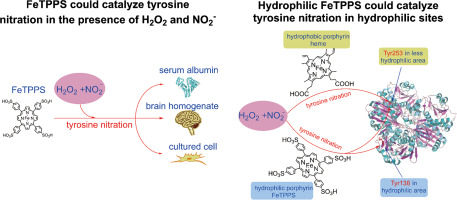Journal of Inorganic Biochemistry ( IF 3.8 ) Pub Date : 2018-03-06 , DOI: 10.1016/j.jinorgbio.2018.03.003 Pengfei Zhang , Lu Ma , Zhen Yang , Hailing Li , Zhonghong Gao

|
5,10,15,20-Tetrakis(4-sulfonatophenyl)porphyrinato iron(III) chloride (FeTPPS) is a water-soluble heme analog, which has been used as a scavenger of peroxynitrite in many studies. Similar to heme, it may also possess pseudo-peroxidase activity that could cause protein tyrosine nitration through the peroxidase-H2O2-NO2− pathway. In this paper, we used western blotting and spectrophotometry analysis to study the capability of FeTPPS in catalyzing protein tyrosine nitration. Furthermore, the capability of FeTPPS in catalyzing protein nitration in tissue homogenate and cultured cells was also investigated. Our results showed that FeTPPS induced bovine serum albumin (BSA) nitration in the presence of H2O2 and NaNO2, and the reaction was dose-, time- and pH-dependent. In acidic condition, more protein was nitrated by FeTPPS than heme, which corresponded to their peroxidase activities. Meanwhile, our results also confirmed the catalytic effect of FeTPPS on protein tyrosine nitration in rat brain homogenate and human hepatocellular carcinoma (HepG2) cells. At the end of this study, we used liquid chromatography (LC)–tandem mass spectrometry (MS/MS) to investigate differences of site selectivity between heme and FeTPPS catalyzed protein tyrosine nitration. The result indicated that FeTPPS tended to catalyze tyrosine residues locating in more hydrophilic sites, whereas heme was more likely to induce nitration of tyrosine residues locating in relatively hydrophobic environment. Taken together, this is the first report that FeTPPS is an effective and convenient nitration catalyzer in vitro, and this study confirms that the hydrophilicity of the nitrating agents would play an important role in nitration site selection.
中文翻译:

5,10,15,20-过氧化亚硝酸盐分解催化剂四(4-磺酰基苯基)卟啉铁(III)氯化铁(FeTPPS)在过氧化氢和亚硝酸盐存在下催化蛋白质酪氨酸硝化
5,10,15,20-四(4-磺酰基苯基)卟啉铁(III)氯化铁(FeTPPS)是一种水溶性血红素类似物,在许多研究中已被用作过氧亚硝酸盐的清除剂。类似于血红素,它也可以具有伪过氧化物酶的活性,可以通过过氧化物酶-H引起蛋白质酪氨酸硝化2 ö 2 -NO 2 -通路。在本文中,我们使用蛋白质印迹和分光光度法分析了FeTPPS催化蛋白质酪氨酸硝化的能力。此外,还研究了FeTPPS在组织匀浆和培养细胞中催化蛋白质硝化的能力。我们的结果表明,FeTPPS在H 2 O 2存在下诱导牛血清白蛋白(BSA)硝化和NaNO 2,反应是剂量,时间和pH依赖性的。在酸性条件下,FeTPPS比血红素能使更多的蛋白质硝化,这与它们的过氧化物酶活性相对应。同时,我们的结果也证实了FeTPPS对大鼠脑匀浆和人肝细胞癌(HepG2)细胞中蛋白质酪氨酸硝化的催化作用。在本研究的最后,我们使用液相色谱(LC)-串联质谱(MS / MS)研究了血红素和FeTPPS催化的蛋白酪氨酸硝化之间位点选择性的差异。结果表明,FeTPPS倾向于催化位于较亲水位置的酪氨酸残基,而血红素更可能诱导位于相对疏水环境中的酪氨酸残基的硝化。在一起在体外,这项研究证实硝化剂的亲水性将在硝化位点的选择中起重要作用。











































 京公网安备 11010802027423号
京公网安备 11010802027423号